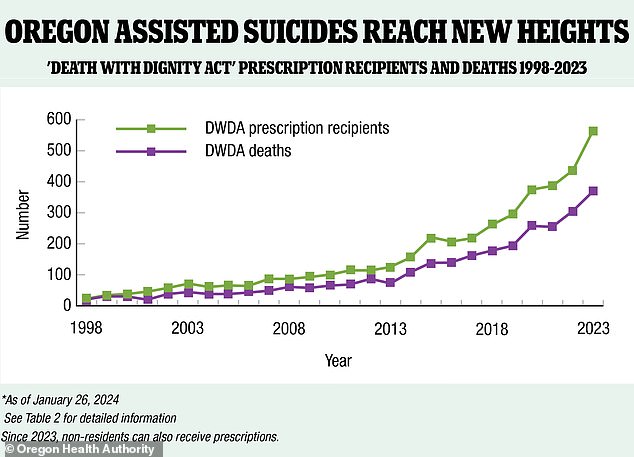Oregon’s physician-assisted suicides rose 21% to 367 by 2023, with many patients vomiting medications and someone taking six days to die in what critics call “cruel or unusual punishment”
Assisted suicide in Oregon rose by a fifth last year to 367 deaths, with more people suffering vomiting and other complications, and one patient taking nearly a week to die.
The States annual report The Death with Dignity Act (DWDA), as the procedures are known, comes as more US states consider allowing the terminally ill to end their lives with lethal doses of prescription drugs.
The 18-page report, published this month, shows that in 2023, 560 people received prescriptions for lethal drugs, and 367 people took the drugs and died from them — both sharp increases from 2022.
The Oregon Health Authority (OHA) said the increase was caused by a recent relaxation of state law allowing people from other states to travel to Oregon and request medications there — a process known as “death tourism.”
Physician-assisted suicide programs are available in all three West Coast states. Pictured: Robert Fuller begins putting the drugs that will end his life into his feeding tube in Seattle, Washington

About 4,274 people have received prescriptions and 2,847 have died from ingesting lethal drugs since Oregon passed the Death with Dignity Act in 1997.
At least 23 nonresidents took advantage of the new scheme last year and ended their lives in Oregon — though officials say that’s likely an undercount since not all such deaths are reported, OHA official Tom Jeanne said.
“The full impact of allowing out-of-state residents to access the law is unclear because information about where the patient lives was not collected during the DWDA prescription process,” says Jeanne.
Those who chose to end their lives in Oregon were overwhelmingly white and elderly; 82 percent of them were 65 years or older.
Most commonly, DWDA recipients suffered from cancer (66 percent), followed by brain disease (11 percent) and heart disease (10 percent).
More than 92 percent of them said they wanted to die because their condition would cause them to lose their autonomy
Many said they worried about life becoming less enjoyable (88 percent), loss of dignity (64 percent) and loss of physical control (47 percent).
A worrying 43 percent say they fear becoming a burden on loved ones.

Dr. Sejal Hathi heads the Oregon health authority, which administers America’s most developed suicide program

An example of the drugs doctors use to end lives in Belgium, which has one of the world’s most developed euthanasia programs
Another 8 percent said they took their own lives because of the cost of their treatment.
Most patients died within an hour of taking their medications – usually a fatal cocktail of diazepam, morphine, phenobarbital and other drugs.

Oregon Health Officer Tom Jeanne
But not all deaths were quick and easy.
Ten people experienced complications, such as vomiting their medication or experiencing a burning sensation in the throat.
One patient took 137 hours (almost six days) to die.
OHA provided no further details about the slow death.
Critics of the DWDA said this was evidence that procedures were unsafe.
“If this had been an execution, it would have been cruel or unusual punishment,” wrote British author Simon Caldwell.
The new figures come amid growing concerns that Oregon and other US states are liberalizing their assisted suicide programs too quickly, following the example of Canada, where 13,241 people were euthanized in 2022.
Physician-assisted suicides are currently allowed in ten states and Washington DC.

Oregon’s physician-assisted suicide program has been controversial from its inception. Pictured: Protesters from both sides of the debate outside the steps of the Supreme Court in Washington in 2005

In Canada, doctors administer lethal injections into the lives of terminally ill patients. In some US states, patients request a prescription for lethal drugs, which they usually take at home
They are being considered in 19 states this year, including Florida, Massachusetts, New York, Tennessee and Virginia.
These bills allow people who have six months or less to live to request prescriptions from a doctor that they can take at home. Doctors can only prescribe the drugs to patients they assess as mentally competent.
Advocates of assisted suicide say they help desperately ill people end their suffering.
Critics say they devalue human life and make death a solution for the sick, the disabled and even those who are strapped for cash or feel like a burden
Oregon became the first U.S. state to allow physician-assisted suicide in 1997, allowing terminally ill adult Oregonians, who had less than six months to live, to ask doctors for a fatal dose of drugs that they then administered to themselves, usually At home.
In 2023, it became the first US state to allow non-residents to travel to the west coast state to end their lives.
Out-of-state residents must be allowed to spend at least 15 days in Oregon to process the paperwork, which requires signatures from two doctors and witnesses, before they can administer the fatal dose themselves.
